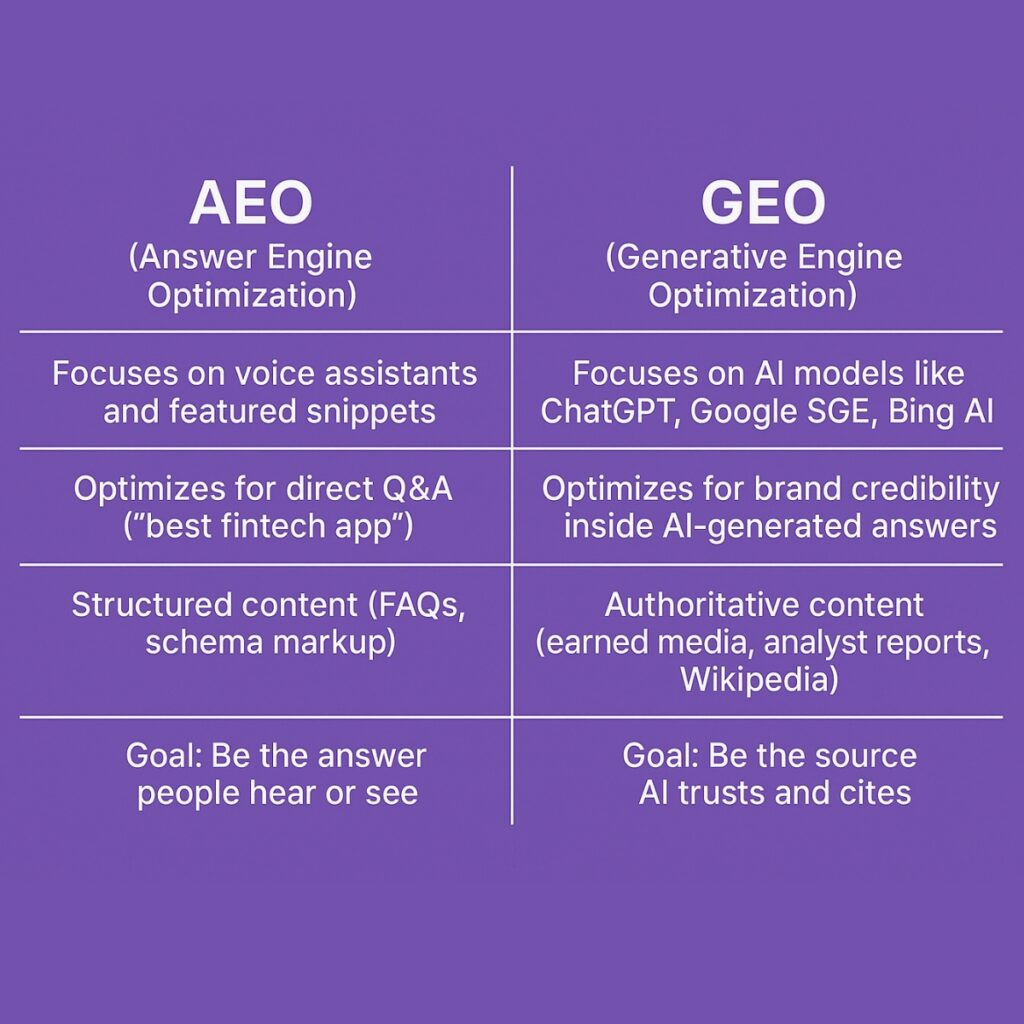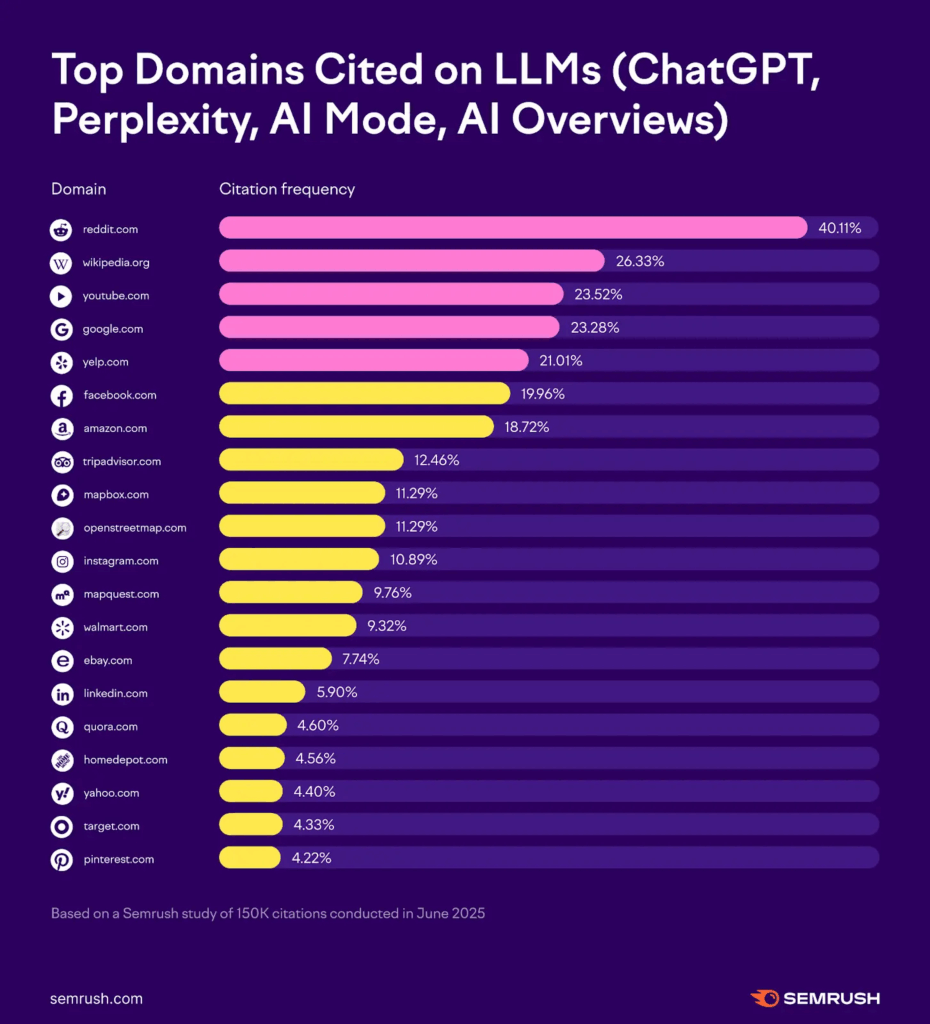
The PR game is shifting fast. Generative AI and answer engines are killing the ten blue links and replacing them with one synthesized answer. By 2026, Gartner predicts one in four search queries will disappear. That’s 25 percent fewer chances to be discovered the old way. If your brand isn’t part of that one answer, you’re invisible. It’s like showing up to the party only to find the guest list was rewritten by ChatGPT and you didn’t make the cut.

What are AEO and GEO?
- Answer Engine Optimization (AEO): Structure your content so it delivers clear answers to specific questions. Think voice search results, featured snippets, and FAQs. When someone asks Siri, Alexa, or Google Assistant a question, AEO helps make sure your answer is the one they hear.
- Generative Engine Optimization (GEO): Train AI models like ChatGPT, Google’s SGE, and Bing AI to recognize, trust, and cite your content. This isn’t about being “searchable,” it’s about being part of the training data these models rely on to generate responses.
In short, AEO gets you heard. GEO makes the AI give you credit.
Consider the difference:
- AEO ensures when (any of the bots you ask questions to) answers, “The best fintech app for freelancers is X.”
- GEO ensures ChatGPT adds, “According to a recent TechCrunch feature, X has grown 200 percent year over year.”
One is about instant answers. The other is about long-term credibility in the algorithmic bloodstream.

Why this matters
AI is the new gatekeeper. It doesn’t care about your tagline. It cares about credibility, clarity, and consistency. Nearly 80 percent of chatbot referrals now come from ChatGPT alone. If your story isn’t in the sources it trusts, you don’t exist.
This flips the old playbook on its head. A Bloomberg placement isn’t just a media win anymore. It’s algorithmic fuel. When someone asks, “What’s the top cybersecurity startup in 2025?” the AI will surface whoever it trusts most. That’s where PR shifts from nice-to-have to mission-critical.
And let’s be clear, AI doesn’t weigh every piece of content equally. Analyst reports, high-authority news sites, Wikipedia, and structured databases count for more. If your brand has been coasting on keyword-stuffed blog posts and recycled press releases, the robots won’t be calling your name. Recent research from SEMRush showed where these LLMs find their information…spoiler It isn’t your website crammed with keywords.

The risks
- Invisibility: Paid search and keyword stuffing won’t cut it. Earned-first is the only way forward. If you aren’t in the sources AI scans and trusts, you’re out of the conversation.
- Measurement gap: In the old world, you could track clicks and impressions. In the new world, AI might quote you without sending a single visit to your site. Imagine giving the smartest quote at the table and no one remembering you said it. That’s the new reality.
- Misinformation: AI models are powerful but flawed. If they pull outdated or wrong details about your company, they’ll spread at scale. If ChatGPT confidently says your company was founded in 1998 when it was actually 2008, wrong is still wrong. And your credibility takes the hit.
- Skills gap: Schema markup, knowledge graphs, content clusters and structured content aren’t optional anymore. PR pros who rely on “just send the release” are already behind. The next generation of PR requires comfort with data and collaboration with SEO and engineering teams.
Where to invest
- Thought leadership: Every article is training data. High quality, research-backed content builds your algorithmic credibility brick by brick.
- Earned media: One Wired mention outweighs twenty no-name blogs. Authority counts more than volume.
- Owned content: Structure matters. FAQs, schema markup, and clean formatting make your insights easier for AI to digest. If your most important thinking is trapped in a PDF, congratulations, you’ve built the Fort Knox of unreadable content.
- Public platforms: Wikipedia, Crunchbase, LinkedIn, and Reddit are often overlooked, but they feed directly into how AI learns about you. Outdated profiles or ghost-town pages tell the algorithm you’re irrelevant.
- AI tools: Start tracking where your brand appears in AI-generated answers. Treat it as your new clippings book. Showing your CEO that “ChatGPT cites us as the leader” will soon be as powerful as a front-page headline.
Expanding the measurement mindset
Measurement is where PR leaders can leap ahead. Traditional web analytics won’t tell the whole story anymore. You’ll need to track:
- Citation frequency: Test AI platforms directly. Ask questions about your category and log how often your brand shows up. Tools are starting to emerge that scrape and benchmark AI outputs at scale, but even a manual “ChatGPT/Perplexity/Writesonic audit” once a month gives you a baseline.
- AI share of voice: Similar to how you measure share of voice in media, compare how often you’re mentioned against competitors. Build a tracker: run the same set of prompts across multiple AI platforms, record who’s named, and calculate percentages. Over time, you’ll see if you’re gaining or losing ground.
- Answer sentiment: Don’t just check if you’re included, check how you’re positioned. Are you the “leading innovator” or the “small player”? Treat AI-generated positioning the same way you’d score traditional media sentiment.
- Referral impact: Even if AI answers don’t send clicks, they shape perception. Pair AI answer tracking with brand lift studies, direct traffic analysis, and search volume trends. If your brand starts appearing more often in AI answers, you should see correlated upticks in awareness, organic mentions, and inbound inquiries.
Building dashboards that capture these new metrics will be just as important as tracking coverage volume. If you’re still reporting purely on impressions and UVMs, you’re missing the bigger picture.
Action plan for PR leaders
1. Audit your earned media footprint and identify gaps in top-tier coverage.
2. Test AI platforms directly. Ask what they say about your brand and your competitors. Treat it like Googling yourself, only scarier.
3. Optimize owned content for structured, simple answers. Bullet points and clarity beat clever headlines.
4. Publish a steady cadence of credible thought leadership. One hit won’t sustain you, but a drumbeat of quality will.
5. Monitor and correct misinformation quickly. Don’t let AI tell your story wrong.
The point of view
The next decade of PR belongs to those who train the machines as well as the journalists. You can’t buy your way into an AI’s trusted answer. You have to earn it.
This is where the fundamentals of PR collide with the future of technology. Credibility. Consistency. Relationships. The same qualities that make reporters trust you are the ones that will make algorithms trust you. The only difference is scale.
Great PR doesn’t just tell a story anymore. It teaches the algorithm which stories matter. Tomorrow’s leaders will be the ones who manage relationships with both journalists and AI. Those who adapt will define their industries. Those who don’t will vanish quietly.
What’s next
This post is the first in a five-part series on AEO and GEO. We’re just scratching the surface here. Over the coming weeks, we’ll break down the tactics, tools, and metrics PR leaders need to win in the algorithmic era. If you want your brand to be the trusted answer, keep reading.





